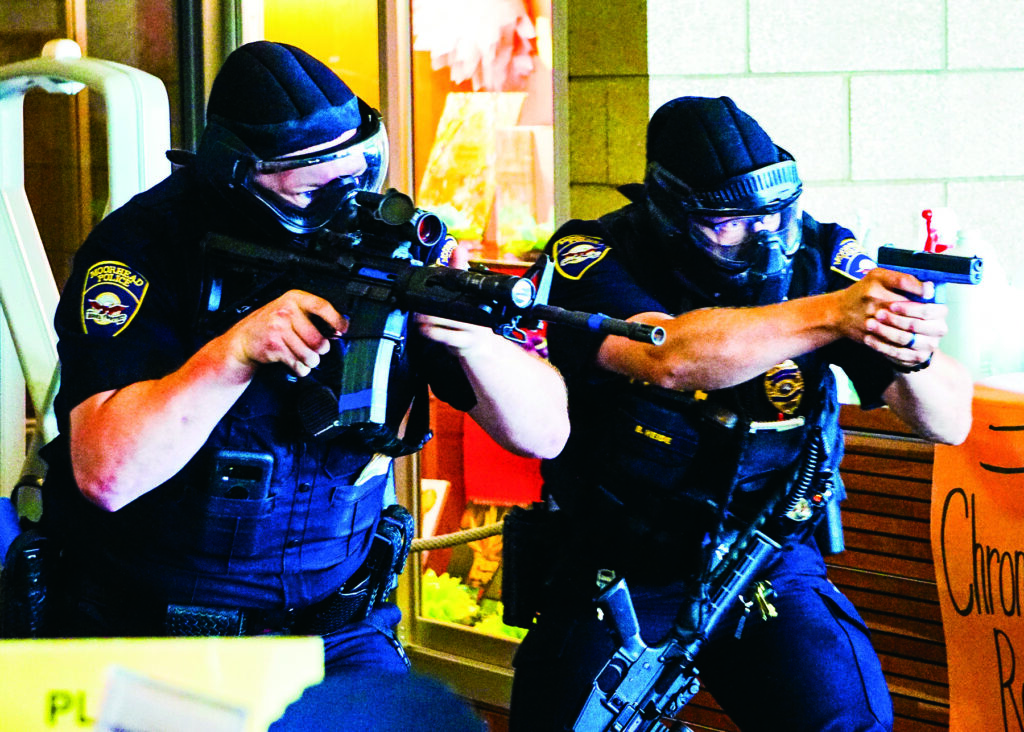
Members of the Moorhead Police Department take part in active shooter training at Horizon Middle School. (Photos/Moorhead Police Department.)
Law enforcement agencies practice active-shooter tactics
Nancy Edmonds Hanson
Five dozen armed and armored law enforcement officers descended on Horizon Middle School last week … not reacting to the kind of active-shooter incident that has made national news this summer, but to practice tactics that they’d employ if the every citizen’s worst nightmare were to occur here.
“This type of training isn’t anything new. We’ve been doing it as a department for close to 20 years,” says Capt. Deric Swenson of the Moorhead Police Department. “We try to do it annually.” The annual practice, disrupted by Covid-19, moved into the planning stage early this year, with a dozen members of the department working on staging the realistic intervention if a school – or a business, a festival, a movie theatre – were threatened.
By Monday, July 18, the critical training was ready to begin. Not only MPD officers took part; members of the Moorhead Fire Department, the Clay County Sheriff’s Department and police from surrounding towns, including Hawley and Barnesville, were on hand to practice the complex tactics of crisis response. School administrators, teachers and staff took part in role-playing for the next three days.
The training in everything from use of force and firearms to communication among responders has been a part of the multi-jurisdictional Cass-Clay Unified School Response plan for more than 15 years. “We work with people from the school side to provide operational emergency plans,” Swenson says. “These are incredibly high-stress situations. Any information we can share will be beneficial. Our goal is that all operations will be coming in under the same plan, including civilians who may be involved.
“Any actions you can predict and familiarize yourself with will become second nature,” he adds. “That’s the difference between prepared and paranoid. Schools have always planned for what to do if there’s a fire. If there’s shooting at a festival, you need to know: ‘What are my options?’”
The police captain explains the importance of informing civilians of how first responders will come into the crisis situation. “We want community members to be as prepared as we are, to the extent that’s possible. It’s still going to be a very stressful time for officers, but if we know what civilians on scene are going to do, it eases the stress.”
The mass shooting in Uvalde, Texas, has added both information and urgency to the law enforcement reenactments. “We can look at what went wrong. We have opinions on what should have happened,” he says. “We are always trying to look and learn.”
The accepted approach has changed since 1999, when two teens killed 13 and wounded 20 at Columbine High School in Littleton, Colorado. Before, standard practice was to wait for better-equipped teams, like SWAT. Today, the first officer on the scene – perhaps the school resource officer – is trained to immediately go to the threat. “I strongly believe that’s what every officer in this community would do,” Swenson emphasizes. “It’s not a natural thing to do. You know the probability of injury is very high. Our officers are trained and committed to put the safety of our community members before themselves.
“Their goal is to get access to the scene by any means – kicking down doors, going through windows, even using their vehicles. When there’s an active threat, they won’t be standing by if they can possibly gain access.”
Moorhead has not faced the kind of incident envisioned in the training so far, though Swenson says there have been “substantiated situations where it could have occurred.” He says the department’s three full-time school resource officers provide an early defense against that unthinkable possibility. “They get to know the students and develop rapport. It’s all about trust. If a students goes to the SRO to tell them what they know, it may avert something much worse.
“They work both ends. It’s about how officers respond to an active threat, but also their role within the district.” That includes relationships with students, school staff and families. Swenson says the SROs get to know who the students are and whom they hang out with. “They can provide support and work through situations that without intervention could wind up as tragedies.”
The Moorhead Police Department has also worked with churches, businesses and public venues to assist them in making their own plans to respond to threats. “We encourage everyone to preplan for these events as much as they can,” he says.
“None of us can assume we will never be in a situation like that. We know we still live in a stable, safe community. But each of us can do our part by being prepared.”
After four hours in the classroom and a walk-though of the school, participants in the training were briefed on specifics like clearing rooms safely and how to engage. Those are tactics that could save lives amidst the chaos and urgency of the moment, with civilians running to safety and other law enforcement personnel – including some unfamiliar faces – running though them to respond.
“Our goal is absolutely not to create trauma, paranoia, fear,” he emphasizes. “But if we know the steps to keep people safer – both members of the community and our own people – it will benefit everyone.”


